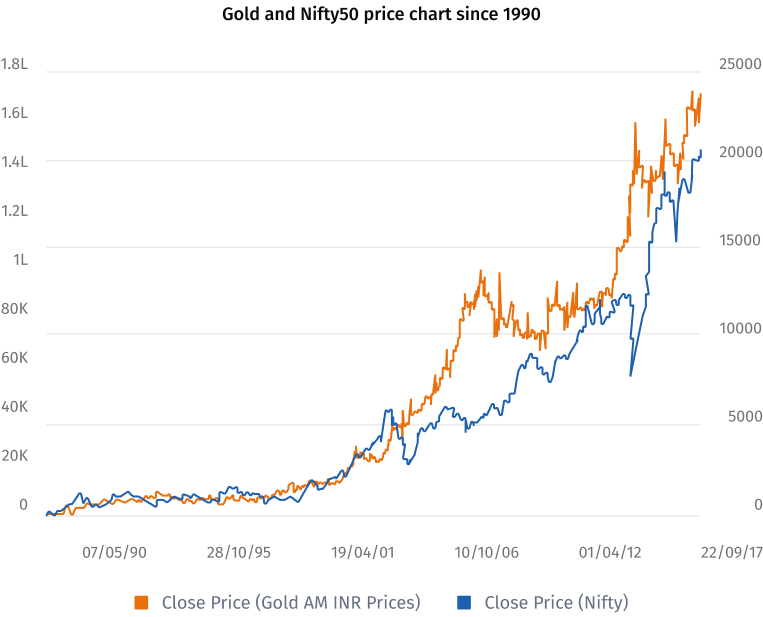1 Finance Magazine
Your trusted source for unbiased and holistic personal finance research
© 2024, Inc. All rights reserved.
The traditional notion for centuries has been to invest in gold jewellery as a household asset to meet future goals. Whereas, equity fund managers at times suggest that gold offers lower returns for more volatility than equity. However, the answer may be somewhere in between.
Many people remain confused about whether to invest in gold or not. Even when they want to invest, they might not know the best method to invest in gold, as there are newer ways to invest in gold like Sovereign Gold Bond (SGB), Gold Exchange Traded Funds (Gold ETFs), Gold leasing, etc.
In this article, we will explore if gold is an investment worth exploring or not.

Historically, gold has been an important part of economies around the world. Gold was first used in ancient times. Gold was first minted into coins by the Romans around 560 BC.
Subsequently, in 1066 AD, King William of England introduced a metallic coin-based currency system. By 1792, the United States had established a bi-metallic silver-gold standard, allowing consumers to exchange paper currency for gold at banks.
In India, the history of gold being used as a tradition during weddings dates back to times when property laws favoured the male child. At the time of inheritance, the real estate assets went to the male child so people gifted gold to their daughters at the time of their weddings.
Apart from being a medium of exchange and being gifted during wedding ceremonies, gold also has industrial uses. It has industrial use cases in the electronics, aeronautics and dental industries as well.
On top of all this, it is scarce in nature. Unlike fiat currency, it can’t be printed freely. For reasons like these, investors have been reverting to gold, which has been a fall-back asset class for investors in times of economic uncertainty around the world.
For example, if we talk about the impact of World War I and the 1929 crash, they destabilised currencies. Sections of the world witnessed hyperinflation during the war and the public lost confidence post-1929. This prompted a shift towards safer assets, particularly gold. Bank collapses and decreased business investments ensued.
Hence, it has been historically seen that gold is a hedge for bad times and inflation.
For instance, look at this chart. This shows you the INR price trajectory of Gold AM prices from the year 1990 till date vs Nifty 50.
During times of crisis (marked by the Nifty 50 index falling down), gold prices have shot up.
We heard a portfolio manager say in a show, “Things have changed the way they used to be 100 years ago. Now, gold doesn’t really act as a hedge against inflation.”
However, this chart reflects that during the global financial crisis of 2008, the COVID crisis of 2020, the Ukraine-Russia war of 2022, and even the recent Israel-Palestine conflict, gold prices have elevated in times of crisis and have acted as a hedge against equities.

The Nifty 50 (not TRI) has returned 13.63% since July 1990, whereas gold has returned 10.33% in the same period. Obviously, holding Nifty 50 would’ve come with dividends and holding gold would’ve meant holding costs, a higher transaction cost and a buy-sell spread.
But our point is not to portray one asset class as superior to the other. Our objective is to make our users aware of the importance of asset allocation, as one acts as a hedge against the other.
Talking about volatility or standard deviation, the Nifty has been more volatile than gold. Since July 1990, Nifty 50’s standard deviation has been 1.27%, whereas that of Gold has been 0.90%.
Speaking of which, one may argue that gold’s volatility adjusted returns have been superior to the Nifty 50.
Gold and Nifty50 needn’t be viewed as arch-rivals and you may still consider buying both while maintaining a fair asset allocation strategy based on your risk profile and horizon of financial goals. Do consult a SEBI registered investment advisor before making any investment decisions.
In a different article, we shall cover the different ways available today to invest in gold and do an in-depth comparative analysis between them to help you educate yourself on the best choice for yourself.
Please note that this has been shared solely from an educational standpoint.
Table of Contents
Share: